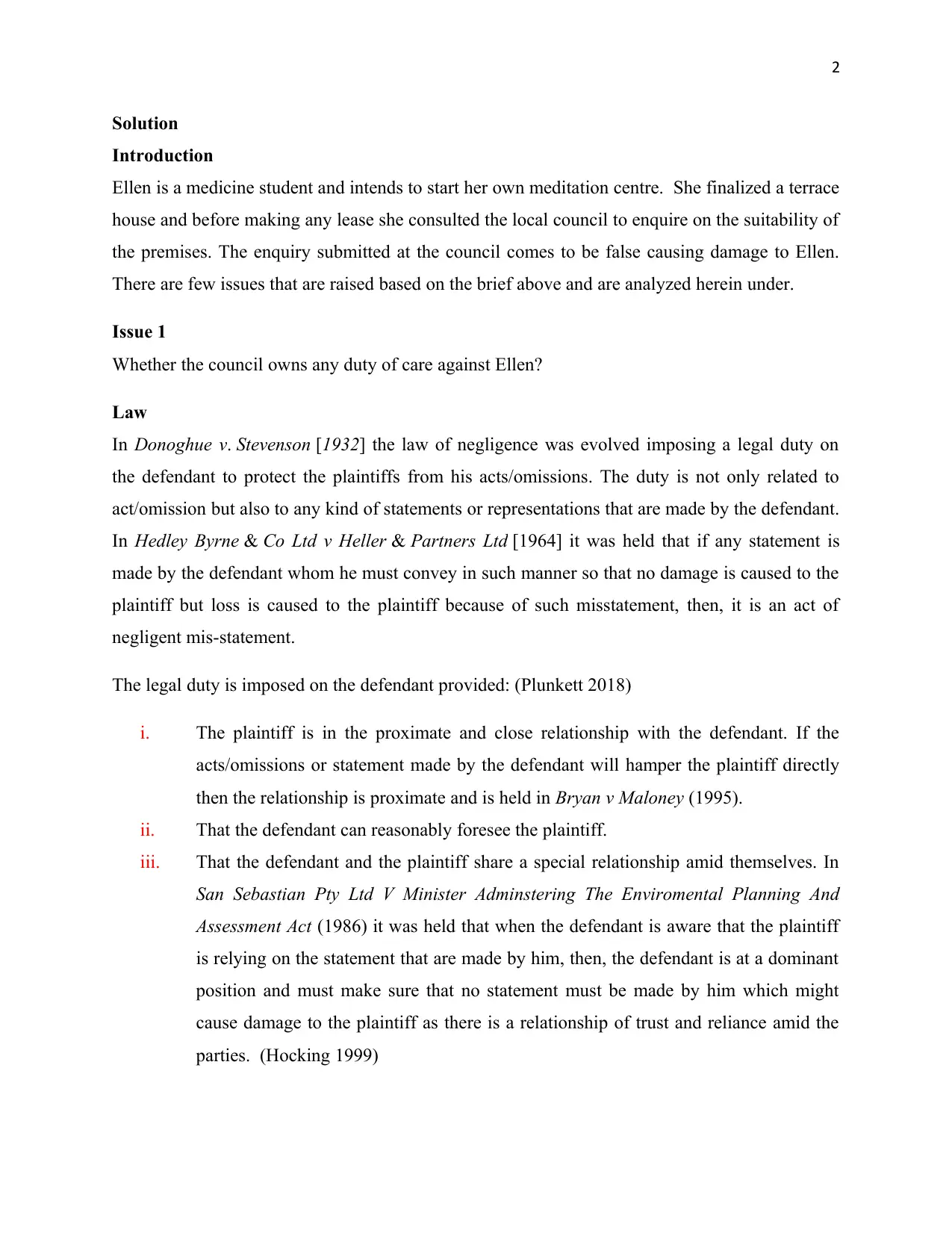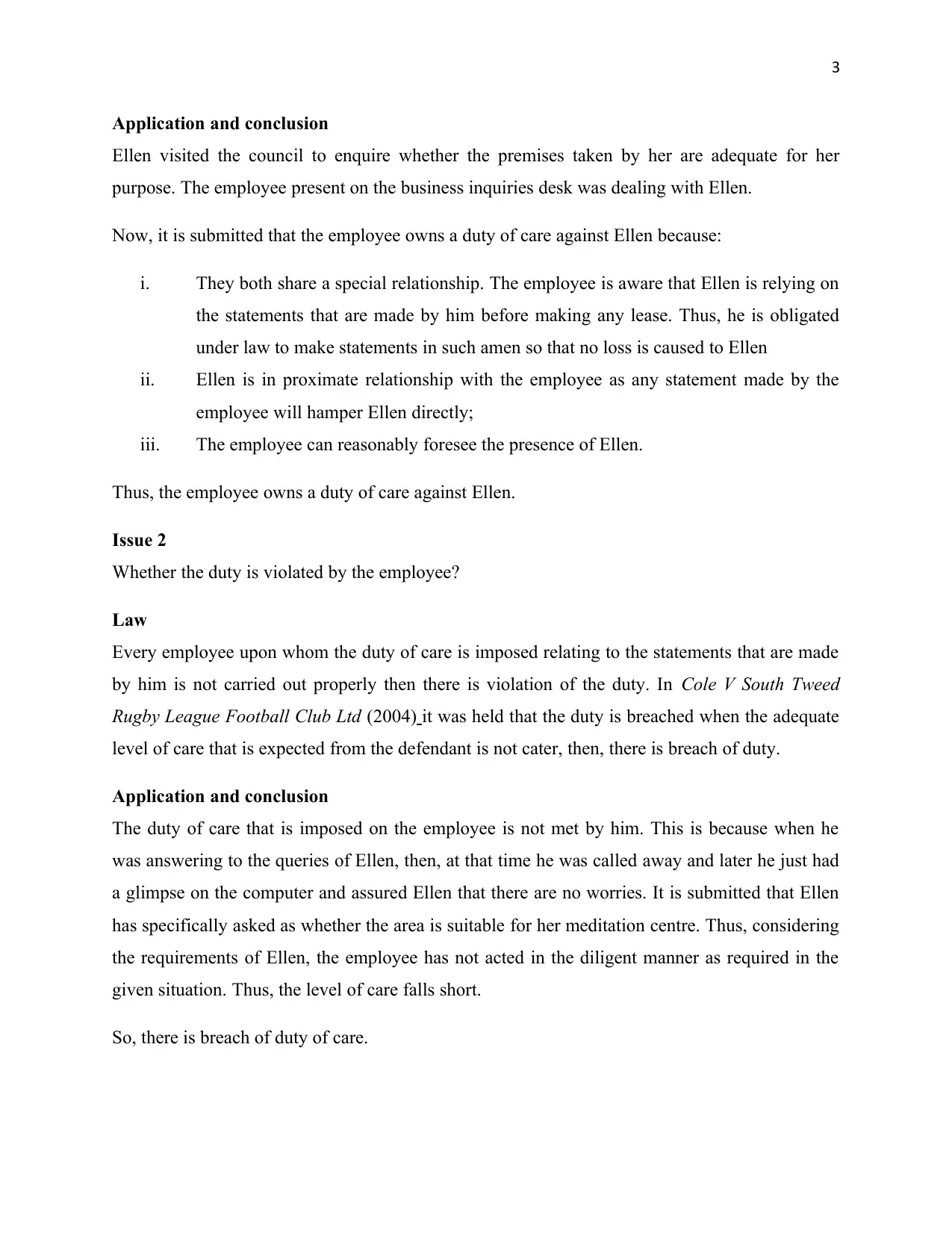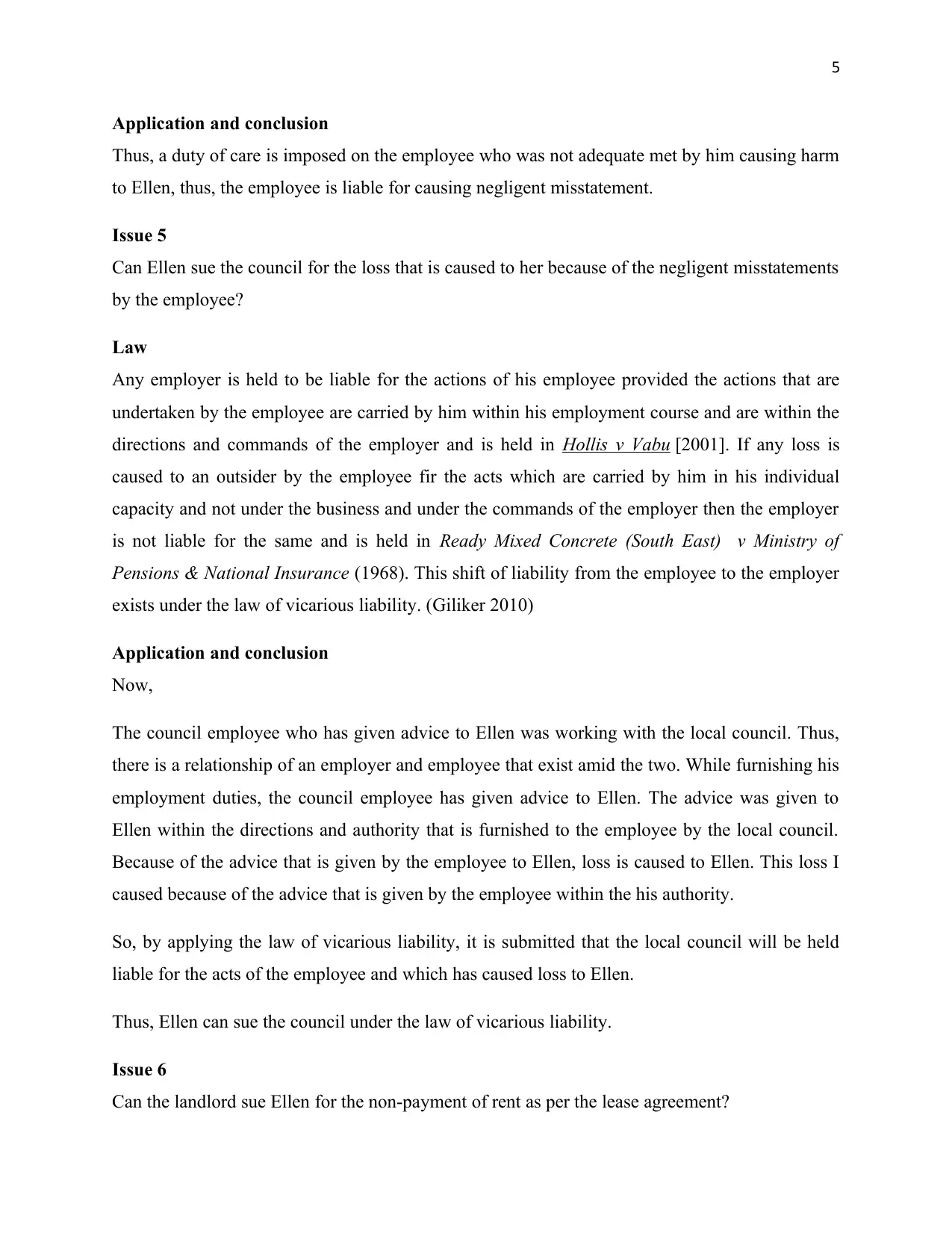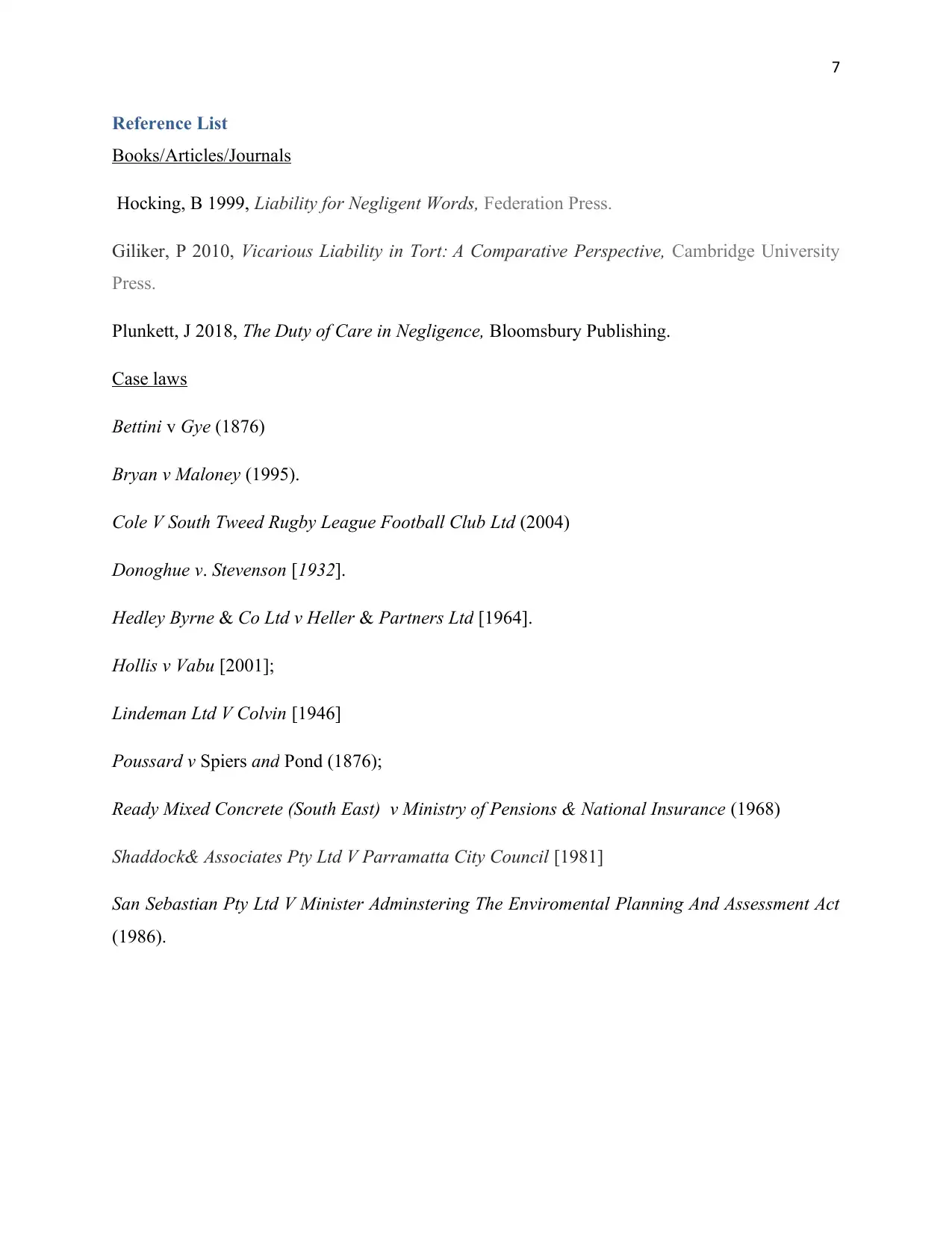LAW100 Business Law Case Study: Negligent Misstatement and Liability
VerifiedAdded on 2023/06/04
|7
|1910
|190
Case Study
AI Summary
This case study analyzes a scenario involving Ellen, a medicine student, who intends to open a meditation center and leases a terrace house after consulting the local council regarding the suitability of the premises. The council employee's negligent misstatement, where he assured Ellen of a calm environment without proper investigation, leads to several legal issues. The assignment explores whether the council owed Ellen a duty of care, if that duty was breached, and if Ellen suffered damages as a result. It further examines the employee's liability for negligent misstatement and whether Ellen can sue the council under vicarious liability. Finally, it addresses the landlord's ability to sue Ellen for non-payment of rent due to business disruptions. The analysis covers key legal concepts such as duty of care, negligent misstatement, vicarious liability, and contract law, with references to relevant case laws like Donoghue v. Stevenson, Hedley Byrne & Co Ltd v Heller & Partners Ltd, and Hollis v Vabu, providing a comprehensive legal framework to address the issues presented in the case.

1
Contents
Solution............................................................................................................................................2
Introduction......................................................................................................................................2
Issue 1..............................................................................................................................................2
Law...............................................................................................................................................2
Application and conclusion..........................................................................................................2
Issue 2..............................................................................................................................................3
Law...............................................................................................................................................3
Application and conclusion..........................................................................................................3
Issue 3..............................................................................................................................................3
Law...............................................................................................................................................3
Application and conclusion..........................................................................................................4
Issue 4..........................................................................................................................................4
Law...............................................................................................................................................4
Application and conclusion..........................................................................................................4
Issue 5..............................................................................................................................................4
Law...............................................................................................................................................4
Application and conclusion..........................................................................................................4
Issue 6..............................................................................................................................................5
Law...............................................................................................................................................5
Application and conclusion..........................................................................................................5
Reference List..................................................................................................................................6
Contents
Solution............................................................................................................................................2
Introduction......................................................................................................................................2
Issue 1..............................................................................................................................................2
Law...............................................................................................................................................2
Application and conclusion..........................................................................................................2
Issue 2..............................................................................................................................................3
Law...............................................................................................................................................3
Application and conclusion..........................................................................................................3
Issue 3..............................................................................................................................................3
Law...............................................................................................................................................3
Application and conclusion..........................................................................................................4
Issue 4..........................................................................................................................................4
Law...............................................................................................................................................4
Application and conclusion..........................................................................................................4
Issue 5..............................................................................................................................................4
Law...............................................................................................................................................4
Application and conclusion..........................................................................................................4
Issue 6..............................................................................................................................................5
Law...............................................................................................................................................5
Application and conclusion..........................................................................................................5
Reference List..................................................................................................................................6
Paraphrase This Document
Need a fresh take? Get an instant paraphrase of this document with our AI Paraphraser

2
Solution
Introduction
Ellen is a medicine student and intends to start her own meditation centre. She finalized a terrace
house and before making any lease she consulted the local council to enquire on the suitability of
the premises. The enquiry submitted at the council comes to be false causing damage to Ellen.
There are few issues that are raised based on the brief above and are analyzed herein under.
Issue 1
Whether the council owns any duty of care against Ellen?
Law
In Donoghue v. Stevenson [1932] the law of negligence was evolved imposing a legal duty on
the defendant to protect the plaintiffs from his acts/omissions. The duty is not only related to
act/omission but also to any kind of statements or representations that are made by the defendant.
In Hedley Byrne & Co Ltd v Heller & Partners Ltd [1964] it was held that if any statement is
made by the defendant whom he must convey in such manner so that no damage is caused to the
plaintiff but loss is caused to the plaintiff because of such misstatement, then, it is an act of
negligent mis-statement.
The legal duty is imposed on the defendant provided: (Plunkett 2018)
i. The plaintiff is in the proximate and close relationship with the defendant. If the
acts/omissions or statement made by the defendant will hamper the plaintiff directly
then the relationship is proximate and is held in Bryan v Maloney (1995).
ii. That the defendant can reasonably foresee the plaintiff.
iii. That the defendant and the plaintiff share a special relationship amid themselves. In
San Sebastian Pty Ltd V Minister Adminstering The Enviromental Planning And
Assessment Act (1986) it was held that when the defendant is aware that the plaintiff
is relying on the statement that are made by him, then, the defendant is at a dominant
position and must make sure that no statement must be made by him which might
cause damage to the plaintiff as there is a relationship of trust and reliance amid the
parties. (Hocking 1999)
Solution
Introduction
Ellen is a medicine student and intends to start her own meditation centre. She finalized a terrace
house and before making any lease she consulted the local council to enquire on the suitability of
the premises. The enquiry submitted at the council comes to be false causing damage to Ellen.
There are few issues that are raised based on the brief above and are analyzed herein under.
Issue 1
Whether the council owns any duty of care against Ellen?
Law
In Donoghue v. Stevenson [1932] the law of negligence was evolved imposing a legal duty on
the defendant to protect the plaintiffs from his acts/omissions. The duty is not only related to
act/omission but also to any kind of statements or representations that are made by the defendant.
In Hedley Byrne & Co Ltd v Heller & Partners Ltd [1964] it was held that if any statement is
made by the defendant whom he must convey in such manner so that no damage is caused to the
plaintiff but loss is caused to the plaintiff because of such misstatement, then, it is an act of
negligent mis-statement.
The legal duty is imposed on the defendant provided: (Plunkett 2018)
i. The plaintiff is in the proximate and close relationship with the defendant. If the
acts/omissions or statement made by the defendant will hamper the plaintiff directly
then the relationship is proximate and is held in Bryan v Maloney (1995).
ii. That the defendant can reasonably foresee the plaintiff.
iii. That the defendant and the plaintiff share a special relationship amid themselves. In
San Sebastian Pty Ltd V Minister Adminstering The Enviromental Planning And
Assessment Act (1986) it was held that when the defendant is aware that the plaintiff
is relying on the statement that are made by him, then, the defendant is at a dominant
position and must make sure that no statement must be made by him which might
cause damage to the plaintiff as there is a relationship of trust and reliance amid the
parties. (Hocking 1999)

3
Application and conclusion
Ellen visited the council to enquire whether the premises taken by her are adequate for her
purpose. The employee present on the business inquiries desk was dealing with Ellen.
Now, it is submitted that the employee owns a duty of care against Ellen because:
i. They both share a special relationship. The employee is aware that Ellen is relying on
the statements that are made by him before making any lease. Thus, he is obligated
under law to make statements in such amen so that no loss is caused to Ellen
ii. Ellen is in proximate relationship with the employee as any statement made by the
employee will hamper Ellen directly;
iii. The employee can reasonably foresee the presence of Ellen.
Thus, the employee owns a duty of care against Ellen.
Issue 2
Whether the duty is violated by the employee?
Law
Every employee upon whom the duty of care is imposed relating to the statements that are made
by him is not carried out properly then there is violation of the duty. In Cole V South Tweed
Rugby League Football Club Ltd (2004) it was held that the duty is breached when the adequate
level of care that is expected from the defendant is not cater, then, there is breach of duty.
Application and conclusion
The duty of care that is imposed on the employee is not met by him. This is because when he
was answering to the queries of Ellen, then, at that time he was called away and later he just had
a glimpse on the computer and assured Ellen that there are no worries. It is submitted that Ellen
has specifically asked as whether the area is suitable for her meditation centre. Thus, considering
the requirements of Ellen, the employee has not acted in the diligent manner as required in the
given situation. Thus, the level of care falls short.
So, there is breach of duty of care.
Application and conclusion
Ellen visited the council to enquire whether the premises taken by her are adequate for her
purpose. The employee present on the business inquiries desk was dealing with Ellen.
Now, it is submitted that the employee owns a duty of care against Ellen because:
i. They both share a special relationship. The employee is aware that Ellen is relying on
the statements that are made by him before making any lease. Thus, he is obligated
under law to make statements in such amen so that no loss is caused to Ellen
ii. Ellen is in proximate relationship with the employee as any statement made by the
employee will hamper Ellen directly;
iii. The employee can reasonably foresee the presence of Ellen.
Thus, the employee owns a duty of care against Ellen.
Issue 2
Whether the duty is violated by the employee?
Law
Every employee upon whom the duty of care is imposed relating to the statements that are made
by him is not carried out properly then there is violation of the duty. In Cole V South Tweed
Rugby League Football Club Ltd (2004) it was held that the duty is breached when the adequate
level of care that is expected from the defendant is not cater, then, there is breach of duty.
Application and conclusion
The duty of care that is imposed on the employee is not met by him. This is because when he
was answering to the queries of Ellen, then, at that time he was called away and later he just had
a glimpse on the computer and assured Ellen that there are no worries. It is submitted that Ellen
has specifically asked as whether the area is suitable for her meditation centre. Thus, considering
the requirements of Ellen, the employee has not acted in the diligent manner as required in the
given situation. Thus, the level of care falls short.
So, there is breach of duty of care.
⊘ This is a preview!⊘
Do you want full access?
Subscribe today to unlock all pages.

Trusted by 1+ million students worldwide

4
Issue 3
Whether damage is caused to Ellen?
Law
When the duty is violated by the defendant, then, it is necessary that loss is caused to the
plaintiff. The damage comes within the preview of negligent mis-statement when the loss is
caused to the plaintiff is reasonably anticipated and is not remote and is held in Shaddock&
Associates Pty Ltd V Parramatta City Council [1981]. Also, the loss that is caused to the plaintiff
should be because of the cause of the defendants negligent statements and is held in Lindeman
Ltd V Colvin [1946].
Application and conclusion
Now, the employee was found to be in breach of his duty. After 6 months of sighing the lease
there was construction work started that will carried out for next 6 months. Because of the said
work there are damages that are suffered by Ellen:
i. Ellen losses business because of the noise that is incurred because of the construction
work. This loss is not remote and can be easily anticipated by the employee. So, the
employee is liable for the loss;
ii. Ellen also suffers from mental breakdown. This loss is not caused because of the
breach on the part of the employee and thus is remote and the employee is not
answerable for the same;
iii. Ellen was not able to pay her rent, but, this loss is alos very remote and the employee
is not liable for the same.
Issue 4
Whether the employee can be held liable for negligent misstatement?
Law
Thus, when the duty of care on the defendant to make the statements accurate are not met as per
the required level and such breach caused loss to the plaintiff, then, the defendant is held liable
for negligent misstatement. (Hocking 1999)
Issue 3
Whether damage is caused to Ellen?
Law
When the duty is violated by the defendant, then, it is necessary that loss is caused to the
plaintiff. The damage comes within the preview of negligent mis-statement when the loss is
caused to the plaintiff is reasonably anticipated and is not remote and is held in Shaddock&
Associates Pty Ltd V Parramatta City Council [1981]. Also, the loss that is caused to the plaintiff
should be because of the cause of the defendants negligent statements and is held in Lindeman
Ltd V Colvin [1946].
Application and conclusion
Now, the employee was found to be in breach of his duty. After 6 months of sighing the lease
there was construction work started that will carried out for next 6 months. Because of the said
work there are damages that are suffered by Ellen:
i. Ellen losses business because of the noise that is incurred because of the construction
work. This loss is not remote and can be easily anticipated by the employee. So, the
employee is liable for the loss;
ii. Ellen also suffers from mental breakdown. This loss is not caused because of the
breach on the part of the employee and thus is remote and the employee is not
answerable for the same;
iii. Ellen was not able to pay her rent, but, this loss is alos very remote and the employee
is not liable for the same.
Issue 4
Whether the employee can be held liable for negligent misstatement?
Law
Thus, when the duty of care on the defendant to make the statements accurate are not met as per
the required level and such breach caused loss to the plaintiff, then, the defendant is held liable
for negligent misstatement. (Hocking 1999)
Paraphrase This Document
Need a fresh take? Get an instant paraphrase of this document with our AI Paraphraser

5
Application and conclusion
Thus, a duty of care is imposed on the employee who was not adequate met by him causing harm
to Ellen, thus, the employee is liable for causing negligent misstatement.
Issue 5
Can Ellen sue the council for the loss that is caused to her because of the negligent misstatements
by the employee?
Law
Any employer is held to be liable for the actions of his employee provided the actions that are
undertaken by the employee are carried by him within his employment course and are within the
directions and commands of the employer and is held in Hollis v Vabu [2001]. If any loss is
caused to an outsider by the employee fir the acts which are carried by him in his individual
capacity and not under the business and under the commands of the employer then the employer
is not liable for the same and is held in Ready Mixed Concrete (South East) v Ministry of
Pensions & National Insurance (1968). This shift of liability from the employee to the employer
exists under the law of vicarious liability. (Giliker 2010)
Application and conclusion
Now,
The council employee who has given advice to Ellen was working with the local council. Thus,
there is a relationship of an employer and employee that exist amid the two. While furnishing his
employment duties, the council employee has given advice to Ellen. The advice was given to
Ellen within the directions and authority that is furnished to the employee by the local council.
Because of the advice that is given by the employee to Ellen, loss is caused to Ellen. This loss I
caused because of the advice that is given by the employee within the his authority.
So, by applying the law of vicarious liability, it is submitted that the local council will be held
liable for the acts of the employee and which has caused loss to Ellen.
Thus, Ellen can sue the council under the law of vicarious liability.
Issue 6
Can the landlord sue Ellen for the non-payment of rent as per the lease agreement?
Application and conclusion
Thus, a duty of care is imposed on the employee who was not adequate met by him causing harm
to Ellen, thus, the employee is liable for causing negligent misstatement.
Issue 5
Can Ellen sue the council for the loss that is caused to her because of the negligent misstatements
by the employee?
Law
Any employer is held to be liable for the actions of his employee provided the actions that are
undertaken by the employee are carried by him within his employment course and are within the
directions and commands of the employer and is held in Hollis v Vabu [2001]. If any loss is
caused to an outsider by the employee fir the acts which are carried by him in his individual
capacity and not under the business and under the commands of the employer then the employer
is not liable for the same and is held in Ready Mixed Concrete (South East) v Ministry of
Pensions & National Insurance (1968). This shift of liability from the employee to the employer
exists under the law of vicarious liability. (Giliker 2010)
Application and conclusion
Now,
The council employee who has given advice to Ellen was working with the local council. Thus,
there is a relationship of an employer and employee that exist amid the two. While furnishing his
employment duties, the council employee has given advice to Ellen. The advice was given to
Ellen within the directions and authority that is furnished to the employee by the local council.
Because of the advice that is given by the employee to Ellen, loss is caused to Ellen. This loss I
caused because of the advice that is given by the employee within the his authority.
So, by applying the law of vicarious liability, it is submitted that the local council will be held
liable for the acts of the employee and which has caused loss to Ellen.
Thus, Ellen can sue the council under the law of vicarious liability.
Issue 6
Can the landlord sue Ellen for the non-payment of rent as per the lease agreement?

6
Law
A contract is made amid two parties wherein they are obligated to comply with the contract
terms. The terms which are decided by the parties themselves are express and the terms which
are made part of the contract by implication of custom, law, and trade are implied terms. Now, in
any contract the terms which are essential for the performance of contract are called conditions,
without conditions the contract will losses its existence and are thus is considered as its roots and
is held in Poussard v Spiers and Pond (1876). Any non-compliance of condition will result in
contract termination and claim of damages. But, when the terms which are not contract essentials
and if not performed will not result in contract termination are warranties and is held in
Bettini v Gye (1876) only damages can be claimed.
Application and conclusion
Because of the loss in the business, Ellen is not able to pay the rent to the landlord. The payment
of rent is very essential term in lease agreement and is thus a condition. Since this essential term
is breached by Ellen then landlord can sue Ellen and terminate the agreement and seek damages.
Law
A contract is made amid two parties wherein they are obligated to comply with the contract
terms. The terms which are decided by the parties themselves are express and the terms which
are made part of the contract by implication of custom, law, and trade are implied terms. Now, in
any contract the terms which are essential for the performance of contract are called conditions,
without conditions the contract will losses its existence and are thus is considered as its roots and
is held in Poussard v Spiers and Pond (1876). Any non-compliance of condition will result in
contract termination and claim of damages. But, when the terms which are not contract essentials
and if not performed will not result in contract termination are warranties and is held in
Bettini v Gye (1876) only damages can be claimed.
Application and conclusion
Because of the loss in the business, Ellen is not able to pay the rent to the landlord. The payment
of rent is very essential term in lease agreement and is thus a condition. Since this essential term
is breached by Ellen then landlord can sue Ellen and terminate the agreement and seek damages.
⊘ This is a preview!⊘
Do you want full access?
Subscribe today to unlock all pages.

Trusted by 1+ million students worldwide

7
Reference List
Books/Articles/Journals
Hocking, B 1999, Liability for Negligent Words, Federation Press.
Giliker, P 2010, Vicarious Liability in Tort: A Comparative Perspective, Cambridge University
Press.
Plunkett, J 2018, The Duty of Care in Negligence, Bloomsbury Publishing.
Case laws
Bettini v Gye (1876)
Bryan v Maloney (1995).
Cole V South Tweed Rugby League Football Club Ltd (2004)
Donoghue v. Stevenson [1932].
Hedley Byrne & Co Ltd v Heller & Partners Ltd [1964].
Hollis v Vabu [2001];
Lindeman Ltd V Colvin [1946]
Poussard v Spiers and Pond (1876);
Ready Mixed Concrete (South East) v Ministry of Pensions & National Insurance (1968)
Shaddock& Associates Pty Ltd V Parramatta City Council [1981]
San Sebastian Pty Ltd V Minister Adminstering The Enviromental Planning And Assessment Act
(1986).
Reference List
Books/Articles/Journals
Hocking, B 1999, Liability for Negligent Words, Federation Press.
Giliker, P 2010, Vicarious Liability in Tort: A Comparative Perspective, Cambridge University
Press.
Plunkett, J 2018, The Duty of Care in Negligence, Bloomsbury Publishing.
Case laws
Bettini v Gye (1876)
Bryan v Maloney (1995).
Cole V South Tweed Rugby League Football Club Ltd (2004)
Donoghue v. Stevenson [1932].
Hedley Byrne & Co Ltd v Heller & Partners Ltd [1964].
Hollis v Vabu [2001];
Lindeman Ltd V Colvin [1946]
Poussard v Spiers and Pond (1876);
Ready Mixed Concrete (South East) v Ministry of Pensions & National Insurance (1968)
Shaddock& Associates Pty Ltd V Parramatta City Council [1981]
San Sebastian Pty Ltd V Minister Adminstering The Enviromental Planning And Assessment Act
(1986).
1 out of 7
Related Documents
Your All-in-One AI-Powered Toolkit for Academic Success.
+13062052269
info@desklib.com
Available 24*7 on WhatsApp / Email
![[object Object]](/_next/static/media/star-bottom.7253800d.svg)
Unlock your academic potential
Copyright © 2020–2025 A2Z Services. All Rights Reserved. Developed and managed by ZUCOL.





